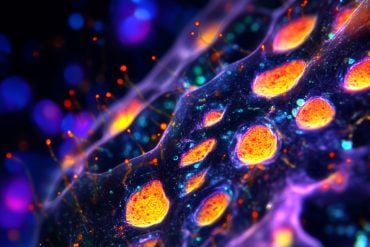Dartmouth researchers studying rats have discovered that activation of designer neural receptors can suppress cravings in a brain region involved in triggering those cravings.
The study is the first to systematically show how designer brain receptors and designer drugs work together to change how cues for food stimulate motivation. The findings, which may help scientists to fight addiction, overeating and other habitual behavior in humans, appear in the European Journal of Neuroscience.
In everyday life, we are bombarded with advertisements, or cues, that garner our attention and trigger us into purchasing products, or rewards. Consequently, these reward-paired cues can become attractive themselves. For example McDonald’s golden arches can produce cravings for fast food even though you haven’t seen the food or aren’t even hungry. Scientists study this phenomenon using sign-tracking, or autoshaping, an experimental conditioning in which the reward is given regardless of the subject’s behavior.
“Although we have a sense of what brain circuits mediate reward, less is known about the neural circuitry underlying the transfer of value to cues associated with rewards,” says lead author Stephen Chang, a postdoctoral fellow. “We were primarily interested in whether the ventral pallidum, a brain region implicated in processing reward, is also involved in sign-tracking.”
Previously, it was impossible to inactivate brain areas like this repeatedly and temporarily to study how cues become valuable in themselves. But it is now possible with a new technology called DREADDs (designer receptors exclusively activated by designer drugs). Your brain cells are loaded with natural receptors, or molecules like jigsaw puzzles that are activated when another molecule arrives that fits like a missing piece. But DREADDs are engineered receptors introduced into neurons using viruses. Injection of a synthetic drug can activate these receptors, thus shutting down the neurons as a sort of remote control.
This technology allowed the Dartmouth researchers to inactivate the ventral pallidum repeatedly and temporarily during tests in which a lever was inserted into the experimental chamber for 10 seconds, followed by a food pellet reward when the lever was withdrawn. Even though the food was delivered regardless of the rats’ behavior, the rats pressed and bit the lever as if it were the reward itself. The results showed that activating DREADDs in the ventral pallidum before each training session blocked that behavior. In addition, recordings of individual neurons in the ventral pallidum following DREADD activation showed that ventral pallidum activity can become suppressed or excited to varying speeds and amounts.

“These results are the first to show that the ventral pallidum is necessary for the attribution of value to cues that are paired with rewards,” Chang says. “This is surprising because the ventral pallidum was historically considered to be just an area for expressing motivations in behavior. In terms of clinical applications, the results carry the potential for stripping away value from reward-paired cues in cases such as addiction. The ventral pallidum is a novel target for such work.”
Source: John Cramer – Dartmouth University
Image Source: The image is credited to Allan Ajifo and is licensed CC BY 2.0
Original Research: Abstract for “Chemogenetic manipulation of ventral pallidal neurons impairs acquisition of sign-tracking in rats” by Stephen E. Chang, Travis P. Todd, David J. Bucci and Kyle S. Smith in European Journal of Neuroscience. Published online November 9 2015 doi:10.1111/ejn.13103
Abstract
Chemogenetic manipulation of ventral pallidal neurons impairs acquisition of sign-tracking in rats
Cues associated with rewarding events acquire value themselves as a result of the incentive value of the reward being transferred to the cue. Consequently, presentation of a reward-paired cue can trigger reward-seeking behaviors towards the cue itself (i.e., sign-tracking). The ventral pallidum (VP) has been demonstrated to be involved in a number of motivated behaviors, both conditioned and unconditioned. However, its contribution to the acquisition of incentive value is unknown. Using a discriminative autoshaping procedure with levers, we investigated the effects of disrupting VP activity in rats on the emergence of sign-tracking using chemogenetics (Designer Receptors Exclusively Activated by Designer Drugs; DREADDs). Transient disruption of VP neurons (activation of the inhibitory hM4D(Gi) DREADD through systemic injections of clozapine N-oxide (CNO) prior to each autoshaping session) impaired acquisition of sign-tracking (lever press rate) without having any effect on approach to the site of reward delivery (i.e., goal-tracking) nor on the expression of sign-tracking after it was acquired. In addition, we conducted electrophysiological recordings in freely behaving rats following VP DREADD activation. The majority of VP units that were responsive to CNO injections exhibited rapid inhibition relative to baseline, a subset of CNO-responsive units showed delayed excitation, and a smaller subset displayed a mixed response of inhibition and excitation following CNO injections. We argue that disruption of VP during autoshaping specifically disrupted the transfer of incentive value that was attributed to the lever cue, suggesting a surprisingly fundamental role for the VP in acquiring compared to expressing Pavlovian incentive values.
“Chemogenetic manipulation of ventral pallidal neurons impairs acquisition of sign-tracking in rats” by Stephen E. Chang, Travis P. Todd, David J. Bucci and Kyle S. Smith in European Journal of Neuroscience. Published online November 9 2015 doi:10.1111/ejn.13103






